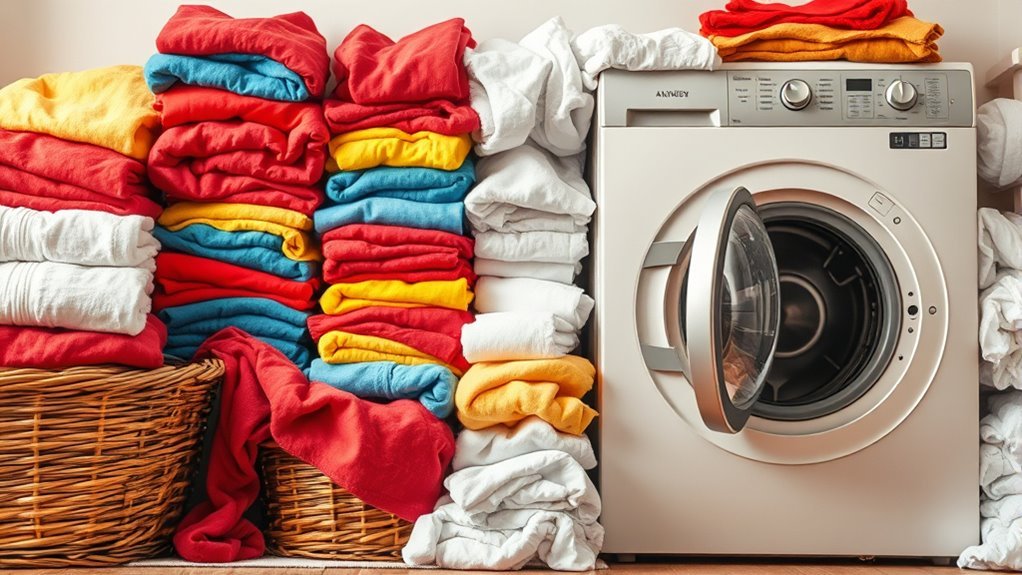Cleaning Tips Before and After Laundry
Before laundry, sort your clothes by fabric type and color to prevent damage and color transfer, and treat stains immediately using the right remover and cold water. Choose detergent suited for your fabrics and machine, measuring carefully, and keep your washer clean to avoid buildup. After washing, dry clothes appropriately—air dry delicates, use low heat for cottons—and reduce wrinkles by shaking out garments or using a steamer. Organize your clean clothes and supplies properly for freshness and ease. There’s more to optimizing your laundry routine for best results.
Sort Clothes by Fabric and Color

Sorting your laundry into at least two categories—by fabric type and color—can prevent damage and maintain the quality of your clothes. When you separate fabrics, you protect delicate items from rougher materials that cause wear. For example, wash cottons separately from synthetics to avoid abrasion. Sorting by color helps you avoid color fading and transfer; keep whites, darks, and colors apart. If you mix, darker dyes may bleed onto lighter fabrics, permanently staining them. Organizing laundry this way also lets you choose appropriate wash cycles and temperatures for each group, preserving fabric integrity and vibrancy. By taking this simple step, you gain freedom from ruined clothes and costly replacements, maintaining your wardrobe’s look and feel longer. It’s an efficient, practical habit that pays off every wash.
Treat Stains Promptly and Effectively
Although stains can seem intimidating, treating them promptly and correctly greatly increases your chances of removing them completely. Quick action is key in effective stain removal and preserving fabric care. Here’s how to tackle stains without hesitation:
Act fast and treat stains promptly to boost removal success and protect your fabrics effectively.
- Blot, don’t rub: Gently absorb excess liquid to avoid pushing the stain deeper.
- Use cold water: It prevents setting protein-based stains like blood or sweat.
- Apply a suitable stain remover: Check fabric care labels to pick the right product.
- Let it sit briefly: Allow the remover to work, but don’t let it dry out.
- Launder promptly: Wash the garment as soon as possible, following fabric care instructions.
Choose the Right Detergent and Amount

Choosing the right detergent depends on your fabric type and washing machine. Always measure detergent carefully to avoid residue or damage. Using the proper detergent and amount guarantees your clothes get clean without wear.
Detergent Types Overview
Detergent plays an essential role in getting your laundry clean, so it’s important to pick the right type for your needs. You’ve got several options, each suited for different fabrics, water types, and stains. Liquid detergents dissolve quickly, making them ideal for cold water washes and pre-treating stains. Powder detergents often cost less and work well on ground-in dirt but may leave residue if not fully dissolved.
Consider these points when choosing:
- Liquid detergents for quick dissolving and stain removal
- Powder detergents for heavy-duty cleaning and affordability
- High-efficiency (HE) detergents for HE machines to save water
- Detergents formulated for sensitive skin or allergies
- Eco-friendly options to reduce environmental impact
Picking the right detergent lets you control how clean and fresh your clothes come out.
Measuring Detergent Properly
Picking the right type of detergent is just one part of the equation—you also need to measure it correctly to get the best results. Detergent measuring is essential to avoid overuse, which wastes product and can leave residue on your clothes, or underuse, which compromises cleaning power. Always follow the dosage guidelines on the detergent packaging; these are tailored to load size, soil level, and water hardness. Use the measuring cap or scoop provided—don’t guess or eyeball. If you’re dealing with a smaller load or lightly soiled clothes, reduce the amount accordingly. Proper detergent measuring saves you money, protects your fabrics, and keeps your washing machine running smoothly. Getting this step right gives you freedom from laundry guesswork and maximizes your detergent’s effectiveness every wash.
Detergent for Fabric Types
Because different fabrics have unique care needs, you’ll want to match your detergent type and amount accordingly. Using fabric specific detergents guarantees your clothes stay vibrant and intact. For example, enzyme detergents benefits include breaking down protein stains gently, ideal for cotton and everyday wear. Delicate fabrics like silk or wool require mild detergents to avoid damage. Always check the detergent label and fabric care instructions to avoid excess residue or fading.
- Use enzyme detergents for cotton and sturdy fabrics.
- Choose gentle detergents for silk, wool, and synthetics.
- Avoid overusing detergent to prevent buildup.
- Opt for fragrance-free options if you have sensitive skin.
- Measure detergent precisely based on load size and soil level.
This approach gives your fabrics the care they deserve while maximizing cleaning freedom.
Clean and Maintain Your Washing Machine

To keep your washing machine running efficiently, regularly remove detergent buildup from the dispenser and drum. Wipe down the drum to prevent odors and clean the door seal to avoid mold and mildew. These simple steps help maintain your machine’s performance and extend its lifespan.
Remove Detergent Residue
Although your washing machine cleans your clothes, it can accumulate detergent residue that affects its performance and leaves buildup on your laundry. To avoid detergent buildup, you need to take simple, regular steps that keep your machine running smoothly and your clothes fresh. Focus on optimizing the rinse cycle and preventing excess soap from sticking around.
- Use the right amount of detergent for each load to prevent leftover residue
- Choose a detergent formulated to reduce buildup in your machine
- Run an extra rinse cycle when you notice soap residue on clothes
- Periodically clean detergent dispensers and seals to remove trapped soap
- Leave the door open after cycles to let moisture evaporate and prevent buildup
Clean Washing Machine Drum
Keeping detergent residue in check is just one part of maintaining your washing machine’s efficiency. To keep your machine running smoothly, incorporate drum cleaning into your regular maintenance routine. Start by running an empty cycle with hot water and a cup of white vinegar or a specialized washing machine cleaner. This helps dissolve buildup, kills bacteria, and removes odors. After the cycle, wipe the drum with a clean cloth to remove any loosened grime. Repeat this process monthly or more often if you notice unpleasant smells or residue. Consistent drum cleaning prevents mold and extends the life of your washer, giving you more freedom from unexpected repairs. Stick to this straightforward maintenance routine, and your washing machine will stay fresh, efficient, and ready for every load.
Maintain Door Seal Cleanliness
The door seal is a common spot where dirt, detergent residue, and moisture build up, creating a perfect environment for mold and mildew. To keep your washing machine fresh and functional, focus on door seal maintenance regularly. This not only prolongs your machine’s life but also supports mold prevention, ensuring your laundry smells clean.
- Wipe the seal with a damp cloth after each wash to remove moisture.
- Inspect the seal weekly for trapped lint or small debris.
- Use a mild detergent solution to clean the seal monthly.
- Leave the door open after use to allow air circulation and drying.
- Avoid using harsh chemicals that could damage the rubber seal.
Consistent care frees you from foul odors and costly repairs, keeping your laundry routine smooth.
Use Proper Drying Techniques for Different Fabrics
When drying your laundry, choosing the right technique for each fabric is essential to maintain its shape and longevity. Delicate fabrics like silk and wool benefit from air drying, which prevents shrinkage and damage from heat. For cotton and durable synthetics, you can use a dryer on a low or medium setting, but avoid high heat to protect fabric care. Always check care labels to match drying methods appropriately. When air drying, hang clothes in a well-ventilated area away from direct sunlight to prevent fading. Avoid overloading your dryer to guarantee even drying and reduce wrinkles. By tailoring your drying approach, you’ll extend your clothes’ lifespan and enjoy the freedom of well-maintained garments without unnecessary wear.
Remove Wrinkles and Freshen Clothes Post-Wash
Although washing removes dirt and odors, your clothes might still come out wrinkled or lack freshness. To keep your wardrobe ready to wear, focus on effective wrinkle removal and fabric freshening techniques. Here’s how you can do it:
Washing cleans but often leaves wrinkles and dullness; effective wrinkle removal and freshening keep clothes ready to wear.
- Shake out garments immediately after washing to reduce wrinkles.
- Use a steamer or iron on appropriate settings for quick wrinkle removal.
- Hang clothes in a well-ventilated area to air out and freshen fabrics naturally.
- Toss in a dryer with a damp cloth for 10-15 minutes to smooth wrinkles and boost freshness.
- Spritz fabric fresheners or diluted essential oils for an added crisp scent.
Store Laundry Supplies and Clean Clothes Properly
Properly storing your laundry supplies and clean clothes guarantees they stay effective and fresh for longer. Start by choosing smart storage solutions that fit your space, like clear containers or labeled bins for detergents and fabric softeners. This keeps everything organized and easy to access, cutting down on clutter and wasted time. For clean clothes, use breathable hampers or drawers with dividers to maintain freshness and prevent wrinkles. Avoid damp or humid areas to stop mildew and odors. Prioritize laundry organization by setting up designated zones for supplies and clean garments, so you can move freely through your routine. With these practical storage solutions, you’ll enjoy a streamlined laundry process and a clutter-free space, giving you more freedom and less hassle every time.
Frequently Asked Questions
How Often Should I Wash My Laundry Baskets?
You should consider your basket cleaning frequency based on how often you do laundry and the basket materials. For plastic or metal baskets, washing them once every two weeks is usually enough to prevent odors and buildup. Fabric or wicker baskets need more gentle cleaning and airing out regularly. If you notice dirt or mildew, clean your basket immediately. Keeping this routine helps you enjoy a fresh laundry space without hassle.
Can I Use Vinegar to Clean My Washing Machine?
You can definitely use vinegar to clean your washing machine. Vinegar benefits include breaking down detergent residue, killing mold, and deodorizing the drum. For effective washing machine maintenance, run an empty hot water cycle with two cups of white vinegar. This simple step helps keep your machine fresh and efficient, saving you money and hassle. Just avoid using vinegar too often, as excessive acidity might damage rubber seals over time.
What Is the Best Way to Clean Dryer Vents?
Think of your dryer vent as the lungs of your dryer—it needs to breathe freely for peak performance. For effective vent cleaning, unplug the dryer, detach the vent hose, and use a vent brush or vacuum to clear lint buildup. Regular dryer maintenance like this prevents fires and boosts efficiency. Make it a habit every few months to keep your dryer running smoothly, giving you more freedom from unexpected breakdowns and higher energy bills.
How Do I Prevent Laundry Odors in My Hamper?
To prevent laundry odors in your hamper, focus on hamper maintenance. Make sure to empty it regularly—don’t let dirty clothes sit for days. Choose a well-ventilated hamper or one with a breathable liner to reduce moisture buildup. You can also toss in odor absorbers like baking soda or charcoal bags. Keeping your hamper clean and dry is key to odor prevention, so wipe it down occasionally and let it air out.
Are Laundry Pods Safe for All Washing Machines?
Laundry pod safety depends on your washing machine’s compatibility. Most modern machines handle pods well, but high-efficiency (HE) washers require pods labeled for HE use to avoid excess suds and damage. Avoid using pods in old top-loaders not designed for them. Always follow your machine’s manual and pod packaging instructions to guarantee safe use. This way, you maintain your freedom to clean efficiently without risking your washer’s performance or your clothes.






